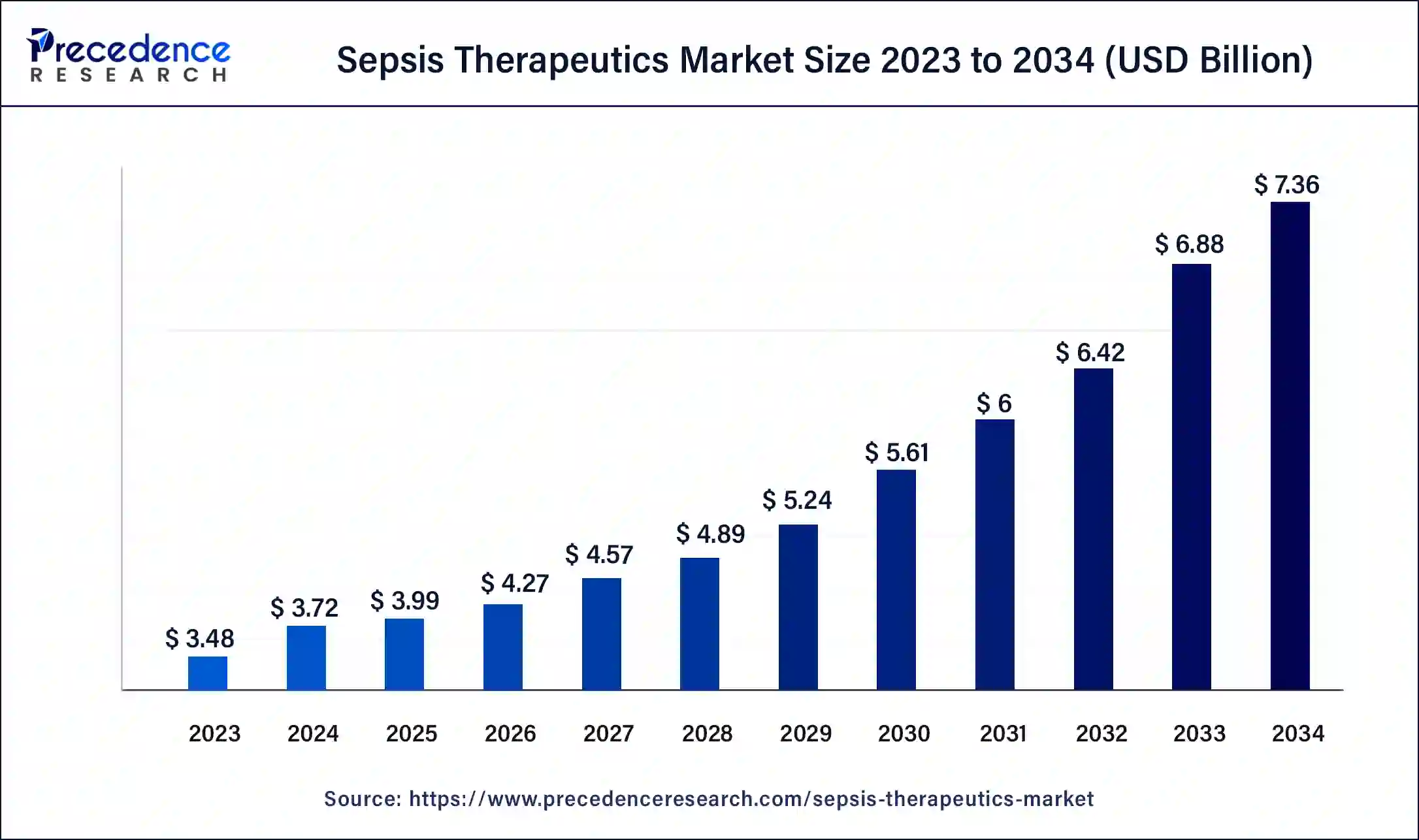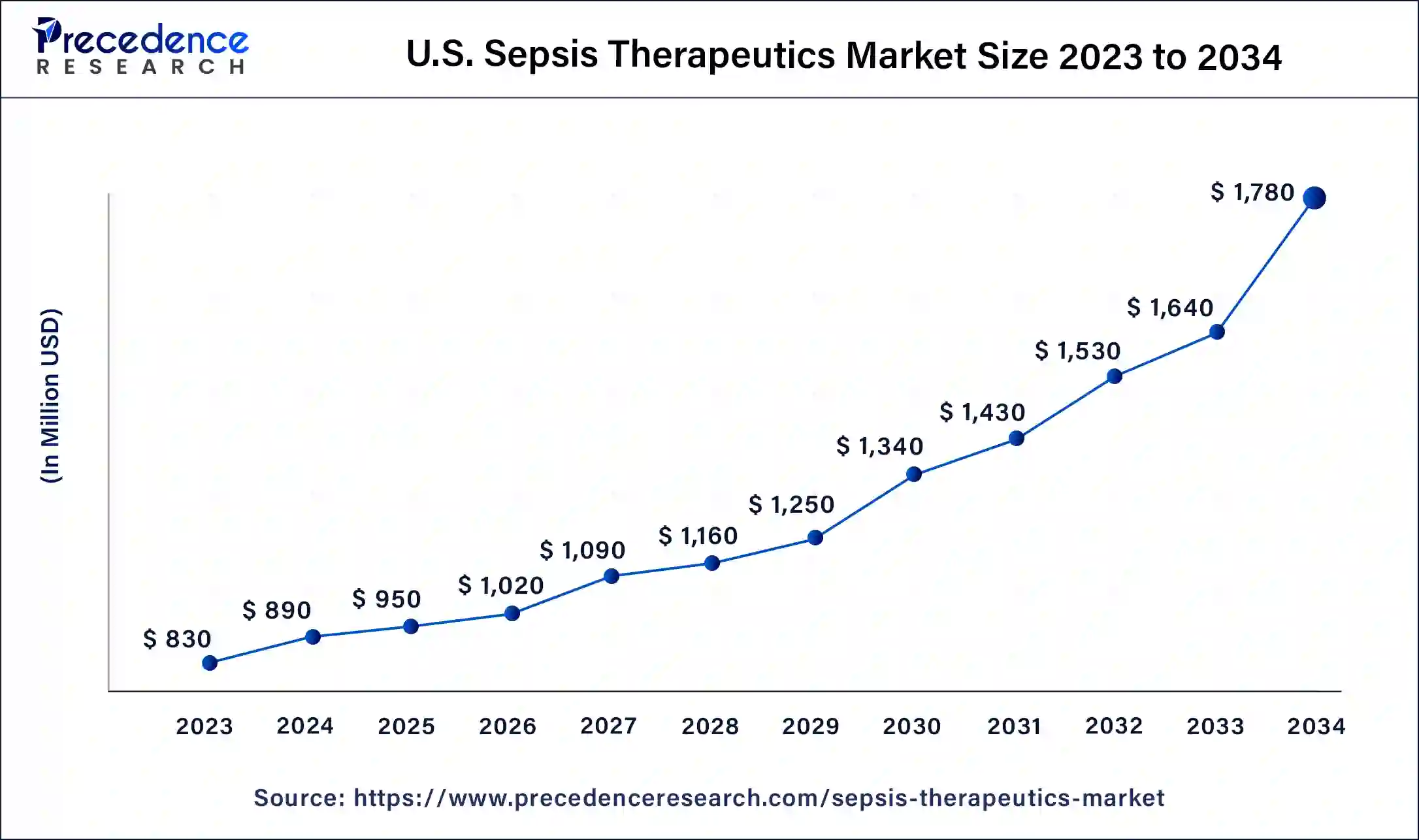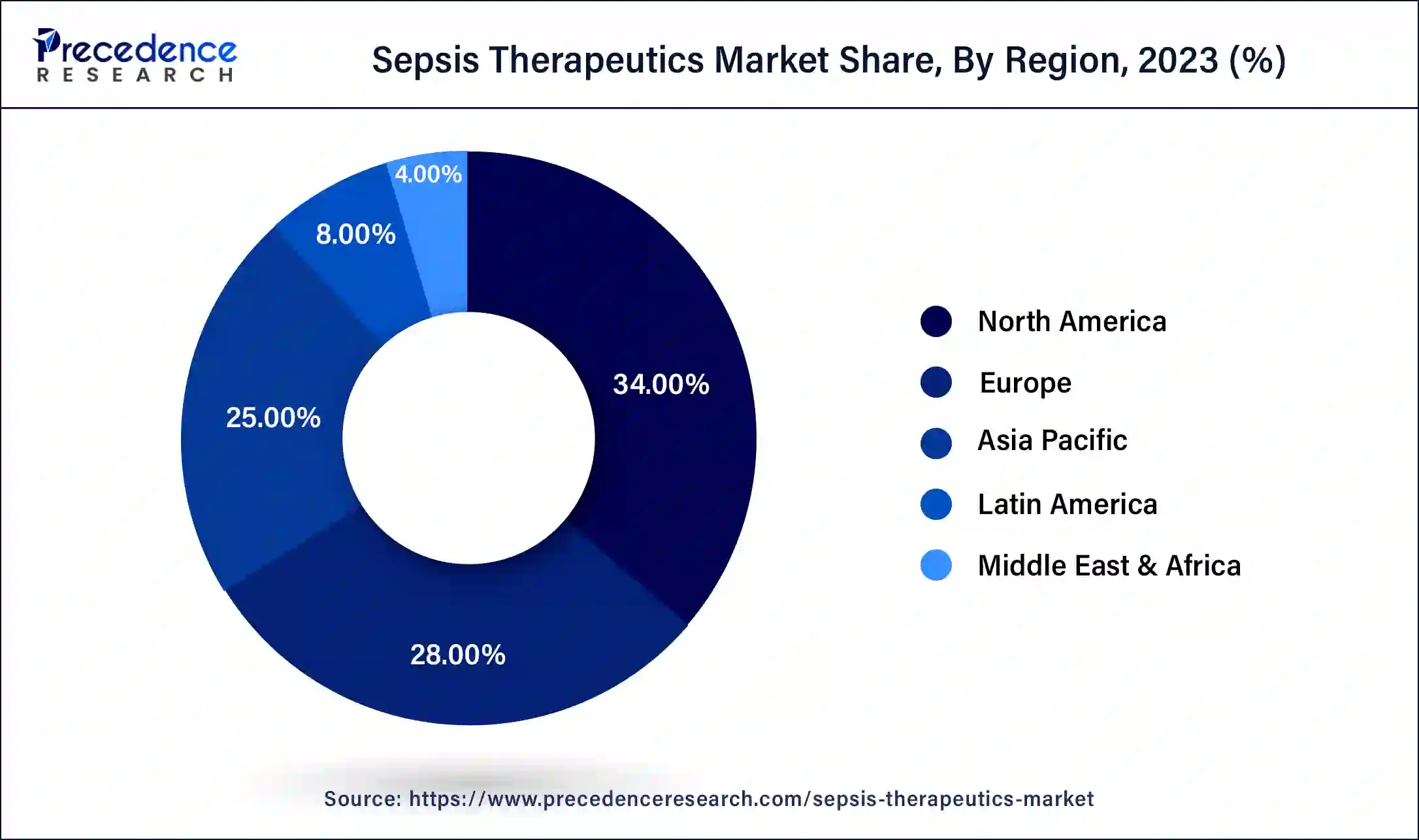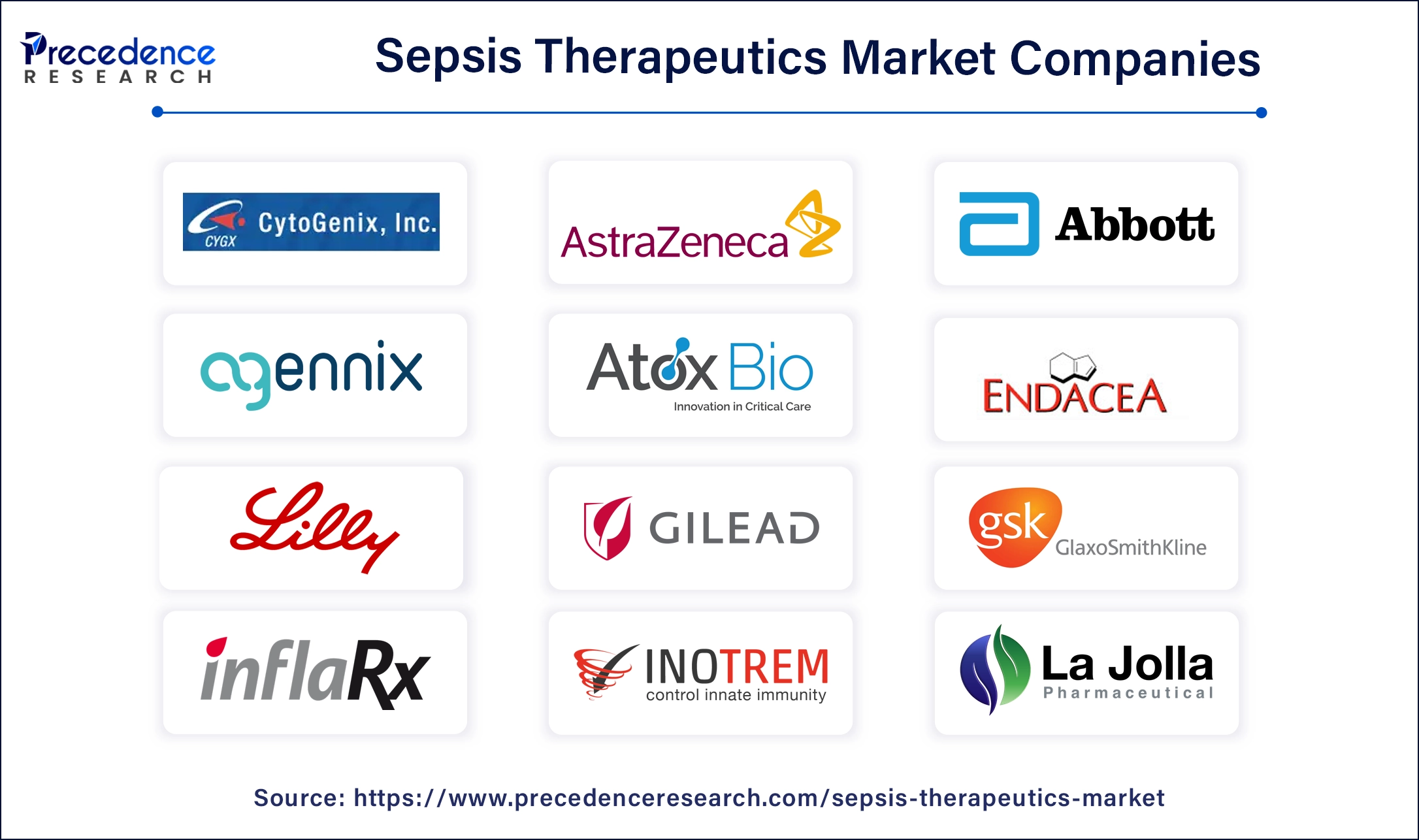September 2024
Sepsis Therapeutics Market (By Type: Aminoglycosides, Second Generation Cephalosporin, Third Generation Cephalosporin, Glycopeptide Antibiotics, Colony Stimulating Factors, Inhaled Intifectives, Other; By Route of Administration: Oral, Injectable, Topical; By Application: Hospitals, Clinics, Others) - Global Industry Analysis, Size, Share, Growth, Trends, Regional Outlook, and Forecast 2024-2034
The global sepsis therapeutics market size is expected to be valued at USD 3.72 billion in 2024 and is predicted to reach around USD 7.36 billion by 2034, expanding at a CAGR of 7.05% from 2024 to 2034. The North America sepsis therapeutics market size reached USD 1.18 billion in 2023. The benefits of sepsis therapeutics include supportive care that includes oxygen, different medicines like antibiotics, vitamins, sedatives, and anti-inflammatory drugs used for the treatment of sepsis and septic shock, and surgery that helps to remove infection sources like dead or infected tissue and pus.

U.S. Sepsis Therapeutics Market Size and Growth 2024 to 2034
The U.S. sepsis therapeutics market size was exhibited at USD 830 million in 2023 and is projected to be worth around USD 1,780 million by 2034, poised to grow at a CAGR of 7.18% from 2024 to 2034.

North America dominated the sepsis therapeutics market in 2023. The availability of advanced treatments, increasing awareness of diseases, and rising prevalence of sepsis contribute to the growth of the market in the North American region. The rising senior population, which is more susceptible to sepsis, well-developed healthcare systems, and increasing collaboration between research institutes and pharmaceutical companies contribute to the market's growth.

Asia Pacific is estimated to be the fastest-growing during the forecast period of 2024-2033. The presence of new treatments, the rising prevalence of sepsis in this region, and the increasing awareness of diseases contribute to the growth of the sepsis therapeutics market. The rising prevalence of sepsis is due to the rising prevalence of chronic diseases, an increase in antibiotic-resistant bacteria, and an increasing senior population contributing to the growth of the market in the Asia Pacific region.
The sepsis therapeutics market includes medical devices, pharmaceuticals, and therapies specially developed for the management and treatment of sepsis. Sepsis therapeutics help to reduce the source of infection, which causes continued immune imbalance and is important for complete sepsis therapy. The sepsis therapeutics benefits include early recognition and diagnosis; antimicrobial therapy includes the use of antimicrobials like antivirals, antifungals, and antibiotics, which is important to improve outcomes. Fluid resuscitation, hemodynamic support, glucocorticoids, adjunctive therapies like antioxidants, blood purification, immunomodulators, anti-inflammatory agents, and synthetic antimicrobial peptides. These factors help to the growth of the market.
| Report Coverage | Details |
| Market Size by 2034 | USD 7.36 Billion |
| Market Size in 2023 | USD 3.48 Billion |
| Market Size in 2024 | USD 3.72 Billion |
| Market Growth Rate from 2024 to 2034 | CAGR of 7.05% |
| Largest Market | North America |
| Base Year | 2023 |
| Forecast Period | 2024 to 2034 |
| Segments Covered | Type, Route of Administration, Application, and Regions |
| Regions Covered | North America, Europe, Asia-Pacific, Latin America, and Middle East & Africa |
Rising incidences of sepsis globally
The rising incidences of sepsis globally lead to the growth of the market. The causes of sepsis include fungal, bacterial, viral, or parasitic infections. Bacterial infections include the bloodstream, abdomen, urinary tract, or lungs. Viruses like COVID-19 or flu may lead to sepsis. The risk factors of sepsis include older adults and very young children, who are highly susceptible, with weakened immune system conditions like HIV, cancer, or diabetes, and chemotherapy-like treatments can increase the risk of sepsis. Diseases like kidney disease or chronic obstructive pulmonary disease (COPD), severe injuries like burns or trauma, and the use of invasive devices like breathing tubes or catheters can lead to sepsis. These factors help the growth of the sepsis therapeutics market.
Challenges in sepsis therapeutics
The challenges in sepsis therapeutics include requiring early identification with the fastest treatment; core measure bundles are a challenge for clinicians, which can hamper the growth of the market. New strategies for the treatment of sepsis face challenges in reaching patients in the ICU (Intensive Care Unit). Lack of effective diagnostic tools, strict regulatory frameworks, lack of awareness of sepsis and its serious results, limited approved drugs availability, and high treatment costs. These factors can restrict the growth of the sepsis therapeutics market.
Advanced technologies and innovations
Advanced technologies and leading companies or organizations' strategic innovations, initiatives, and market presence contribute to market growth. Some advanced technologies for sepsis therapeutics include molecular diagnosis and nanotechnology based solutions like nanosensors for rapid and sensitive detection of sepsis biomarkers like c-reactive protein and procalcitonin. Surface functionalized nanoparticles with antimicrobial peptides improve efficiency by targeting specific microenvironments. These factors help to the growth of the sepsis therapeutics market.
The second-generation cephalosporin segment dominated the sepsis therapeutics market in 2023. A type of antibiotic, second-generation cephalosporins, is used to treat sepsis. They are highly effective for the treatment of infections that are caused due to specific bacteria. Second generation cephalosporins are less active against gram-positive cocci but are improved their activity against gram negative bacilli. These may be prescribed for the treatment of respiratory infections like pneumonia or bronchiolitis. These factors help the growth of the second-generation cephalosporin segment and contribute to the growth of the market.
The aminoglycosides segment is estimated to be the fastest-growing during the forecast period. The aminoglycosides are used for the neonatal sepsis therapeutics. Aminoglycoside therapies include gentamicin and amikacin, which are administered intravenously for infections caused by MDR gram-negative organisms. The benefits of aminoglycosides include tuberculosis treatment, cystic fibrosis treatment, serious infection management, low resistance potential, and synergistic effects, which help the growth of the market. Aminoglycosides are renowned for their broad-spectrum antibacterial activity, which makes them highly effective against a wide range of bacterial pathogens. These factors help to the growth of the sepsis therapeutics market.
The oral segment dominated the sepsis therapeutics market in 2023. The most common route used for medical treatments is the oral route of administration. Orally taken drugs pass through the gastrointestinal tract and are then distributed into every part of the body. For drugs like vitamins, sedatives, anti-inflammatory medicines, and antibiotics, an oral route of administration is used.
The benefits of the oral route of administration include it is generally safe and non-invasive, it does not involve the patient in extra costs, it can be pain-free and self-administered, it is convenient for prolonged and repeated use, and it is the safest, simplest dosing schedule, non-invasive and most convenient method of route of drug administration. There is risk of acute drug reaction is minimal, and no sterile precaution is necessary. These factors help the growth of the oral segment and contribute to the growth of the market.
The injectable segment is the fastest-growing during the forecast period. The injectable route of administration includes the therapy given to the patients by infusions or injections. Infusions are classified as subcutaneous (SC), intravenous (IV), and intramuscular (IM). This type of injectable route of administration benefits includes stored preparations for sustainable action that may be made, self-administration may be possible, absorption is slower to achieve prolonged effect, and a good route of administration, especially in skin infections. These factors help to the growth of the injectable segment and contribute to the growth of the sepsis therapeutics market.
The hospitals segment dominated the sepsis therapeutics market in 2023. Hospital benefits include the highest end-user for the treatment of sepsis. These are made with specific essential personnel and infrastructure for the treatment of sepsis patients effectively and efficiently. Hospital benefits refer to insurance coverage for expenses linked to visiting a hospital for health care. The benefits also include ambulance services, stays in a rehabilitation facility, emergency room visits, outpatient surgery, intensive care, medical supplies, medical treatments, and room and board. Hospitals have committed clinical teams for sepsis prevention and care as knowledgeable agents in infection control and prevention specialists, pharmacists, and medical and nursing staff. These factors help to the growth of the hospital segment and contribute to the growth of the market.
The clinics segment is the fastest-growing during the forecast period. Clinics act as vital places for the treatment and diagnosis of sepsis. Patients may access important treatments and laboratory tests to eliminate the risk of further complications and enhance their prognosis. These factors help to the growth of the clinics segment and contribute to the growth of the sepsis therapeutics market.

Segments Covered in the Report
By Type
By Route of Administration
By Application
By Geography
For inquiries regarding discounts, bulk purchases, or customization requests, please contact us at sales@precedenceresearch.com
No cookie-cutter, only authentic analysis – take the 1st step to become a Precedence Research client
September 2024
August 2024
October 2024
March 2025